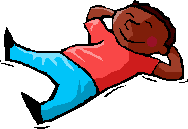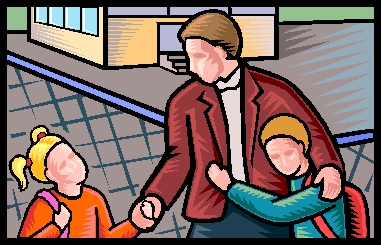arboracademy.com
| |||
FOCUS ON RELAXING “Hurry, hurry we’re late!” This refrain is heard in school households daily; perhaps even among homeschooling families it is heard as we rush out to one of our many ‘fun and educational’ activities. But think carefully, is it also the still, small voice in your head saying “my child does not understand how to do long division and they should have ‘gotten that’ by now”? Perhaps for your child the example is reading level, or science, or history, the point remains the same. Why hold your child and by reflection yourself to some arbitrary outside standard of achievement? You are homeschooling your child to help them learn and grow on their own best time-frame, no hurry involved. We spend a great deal of time focusing and working towards who our child is going to be, perhaps too little on who our child already is; the creative, dynamic, bright, funny and sweet person who is already here, and right on time!
Many people can see that, academically, home education is likely to be an improvement on classroom teaching, if only because children have the chance to learn at their own rate, with one-to-one attention. Research in the USA and elsewhere shows that home educated children tend to achieve academic goals easily, are welcome at university or vocational courses, and are easily able to think for themselves and learn anything they want to learn with confidence. But there are often reservations about socializing, or 'socialization'. Are home educated children isolated from other children? Are they able to make friends with a wide variety of people? Will they be able to fit into society as adults if they haven't been through the ups and downs of school life? Do they become too dependent on their parents, and reluctant to go out to meet new situations and people? What do we mean by socialization anyway? Being sociable People, on the whole, are social creatures. Being sociable is part of our nature. If we allow children to develop in their own way, they will begin to relate to other people when they are ready. Clearly children do need to meet people in order to be sociable, but home educators don't tend to be isolated from the community! A child is just as likely - if not more so - to be sociable with one or two people he meets at home than with a class of 30 children who just happen to be the same age as he is. More importantly, he is far more in control of his social life than he would be in school. Parents - who know their children best - can observe, and encourage, and introduce a shy child to other people at relaxed times, in safe environments rather than forcing them into situations where they may become withdrawn, or angry, or upset. Social skills Social skills include culturally appropriate manners, knowing how to greet different people, and joining in conversations. They are the ways we learn to relate to people in order to build relationships, and to be able to communicate and spend time enjoying company. Our children will primarily learn their social skills and cultural expectations from their parents and those they see around them, so the most important thing you can do is to model the kind of behavior you would like to see. Home educated children are likely to meet a wide variety of people during the week. They may well find it interesting to see how, even within one neighborhood, there are many different ways of behaving. If you are comfortable with your own social skills, it is easier to discuss those of other cultures, and to adapt when appropriate. Social skills are important so that you put other people at ease, and while some broad skills are culturally expected, many will vary from family to family even within the same culture group.
You are a slave. And yet . . . your soul lights up when you hear whispers of attempted escape. Freedom means a hard, dangerous trek. Do you try it?
This site has four main objectives: 1) to educate kids about the environment and the positive and negative effects they can have upon it; 2) to provide both online and at-home activities to reinforce environmental awareness; 3) to highlight the members of SAVE, a group of high school students who have built an environmentally friendly house and whose goal is to educate students and community members about creating and maintaining a healthy environment; and 4) to allow kids to share the ways they have helped the environment themselves.
Personal Exam Self-Tester 2.88
ASL SLanT: Sign Language Teacher 1.06dna
Maze Magic 1.0
JUST FOR FUN Publisher's Description Liquid Dream is a dream journal designed to teach you how to consciously participate in your personal dreamscape. It allows you to find common themes, characters, objects, locations, and anchors throughout the history of your dreams. It also plots graphs showing repetitive occurrences and dreams, and presents your dreams on a calendar.
2004 Arbor Academy, Inc. and the Arbor Academy logo are registered trademarks of Arbor Academy, Inc. Trademarks are property of their respective owners. All rights reserved.
About this newsletter
|
CHN's 2004 Family Expo The Riverside Convention Center in Riverside June 11-12, 2004

Ways of Knowing Trail
SCIENCE CENTER Who's out there? Are humans alone in the universe? Scientists involved in SETI—the Search for Extraterrestrial Intelligence—are using modern technology to search for the answer to this age-old question. What if you were hired to lead such a search? Explore what you need to know to design a SETI research project, then test your skills at searching for alien signals! How will you search? Where will you search? What will you look for?
THE BRITISH EMPIREAt its peak, the British Empire was the largest formal empire that the world had ever known. As such, its power and influence stretched all over the globe; shaping it in all manner of ways. This site is dedicated to analyzing the history of the British Empire: The triumphs, the humiliations, the good that it brought and the bad that it inflicted. For better or worse the British Empire had a massive impact on the history of the world. http://www.britishempire.co.uk/ Writing Skills
While the classic five paragraph essay is a form seldom if ever used by professional writers, it is commonly assigned to students to help them organize and develop their ideas in writing. It can also be a very useful way to write a complete and clear response to an essay question on an exam. It has, not surprisingly, five paragraphs:
We'll look at each type of paragraph, and at transitions, the glue that holds them together. Introduction The introduction should start with a general discussion of your subject and lead to a very specific statement of your main point, or thesis. Sometimes an essay begins with a "grabber," such as a challenging claim, or surprising story to catch a reader's attention. The thesis should tell in one (or at most two) sentence(s), what your overall point or argument is, and briefly, what your main body paragraphs will be about. For example, in an essay about the importance of airbags in cars, the introduction might start with some information about car accidents and survival rates. It might also have a grabber about someone who survived a terrible accident because of an airbag. The thesis would briefly state the main reasons for recommending airbags, and each reason would be discussed in the main body of the essay. Main Body Paragraphs (3) Each main body paragraph will focus on a single idea, reason, or example that supports your thesis. Each paragraph will have a clear topic sentence (a mini thesis that states the main idea of the paragraph) and as much discussion or explanation as is necessary to explain the point. You should try to use details and specific examples to make your ideas clear and convincing. Conclusion Your conclusion begins with a restatement of your main point; but be sure to paraphrase, not just repeat your thesis sentence. Then you want to add some sentences that emphasize the importance of the topic and the significance of your view. Think about what idea or feeling you want to leave your reader with. The conclusion is the reverse of the introduction in that it starts out very specific and becomes a bit more general as you finish. Transitions Transitions connect your paragraphs to one another, especially the main body ones. It's not effective to simply jump from one idea to the next; you need to use the end of one paragraph and/or the beginning of the next to show the relationship between the two ideas. Between each paragraph and the one that follows, you need a transition. It can be built in to the topic sentence of the next paragraph, or it can be the concluding sentence of the first. It can even be a little of both. To express the relationship between the two paragraphs, think about words and phrases that compare and contrast.
Think about your paragraph topics and brainstorm until you find the most relevant links between them. You'll also want some kind of transition from the last paragraph to your conclusion. One way is to sum up your third body paragraph with some reminders of your other paragraphs. You don't need to restate the topics fully (that comes in the conclusion) but you can refer to a detail, or example, or character as a way of pulling your ideas together and signaling that you are getting ready to conclude.
Classical EducationBy Douglas Wilson | ||




 POETRY EXPRESS
POETRY EXPRESS


 Homeschooling Conferences
Homeschooling Conferences

 How to Write a Five Paragraph Essay
How to Write a Five Paragraph Essay 







